Results of campus climate survey discussed by key figures in safety and inclusivity at SIUE
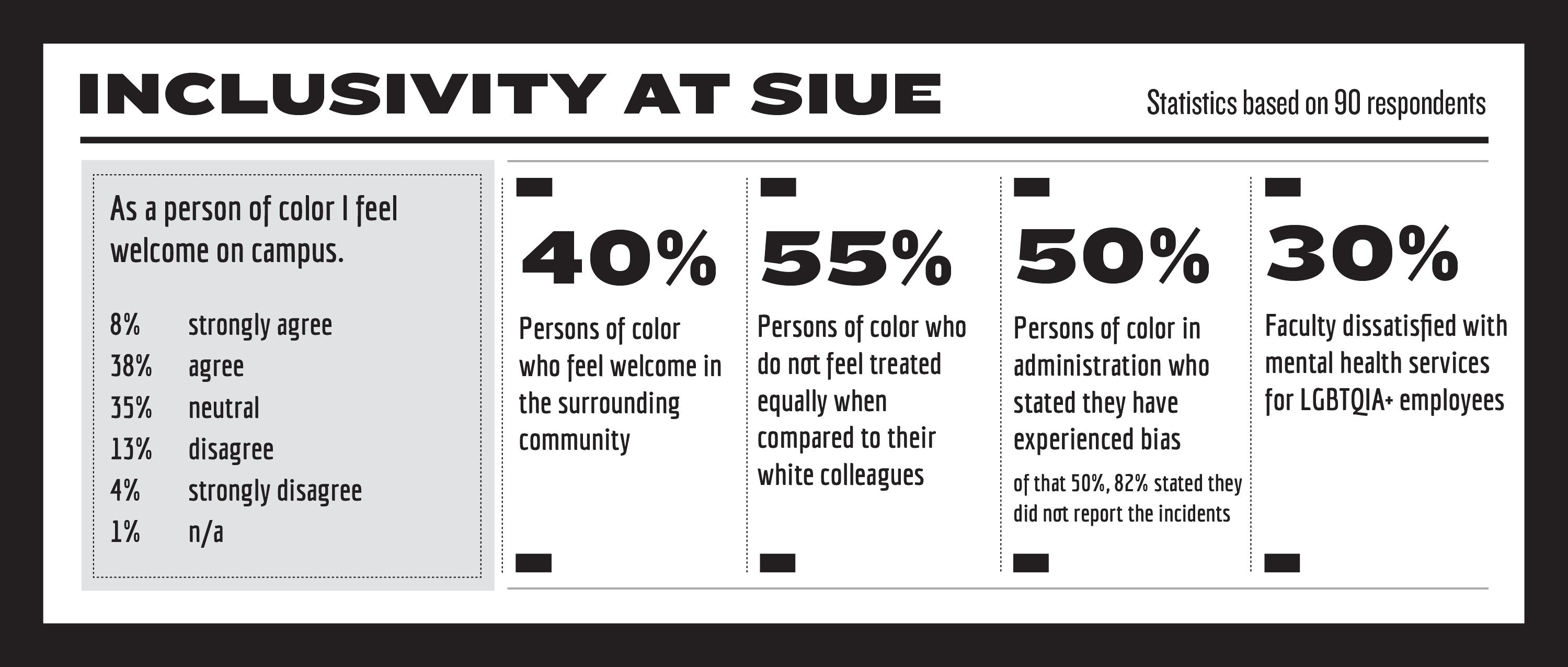 BRUCE DARNELL reporter
BRUCE DARNELL reporter
SIUE’s campus climate survey saw hundreds of responses from students, fac ulty and staff, provoking questions on is sues ranging from freedom of speech to diversity in hiring.
Jessica Harris, Vice Chancellor for Equity, Diversity and Inclusion, hosted a panel at the MUC with other stakehold ers involved in making SIUE safer and more inclusive.
“We’re going to cover five today,” Harris said. “Freedom of speech and diver sity of thought, fairness in hiring, belong ing, bias incident report and response and campus safety.
Approximately 3200 staff, faculty, ad ministrators and students responded total, from all of SIUE’s campuses. The survey had a section for written responses that people could fill out. These comments were discussed early in the panel.
“I pulled out some of the comments that were found throughout SIUE’s sur vey reports from our faculty, staff and students,” Harris said. “I think that you’ll find that these comments are very telling in terms of where we are as a campus com munity and speak to the work we have in front of us.”
Some of the comments came from people holding conservative or Chris tian beliefs, many of whom criticized SIUE for not making them feel welcome on campus.

“A comment from a student, ‘I don’t like how nonchalantly some professors treat viewpoints they don’t agree with, in particular one of my professors is very anti-Christian and [anti-right-wing],’ and again I’ve just pulled several comments, but they reflect patterns if you read through all of the feedback in the survey,” Harris said.
Jerrica Ampadu, an assistant nursing professor and Director of Student Nurses Achievement Program, felt uncomfortable after hearing these comments.
“We started talking about the an ti-racist fatigue and that was quite discour aging for me,” Am padu said. “Because the person who tells the story controls the narrative. SIUE is a predominantly white institution, I even pulled some in formation from the fact book; in 2018 to 2021 we only hired 14 Black faculty mem bers out of 105.”
Ampadu is a healthcare profes sional that works pri marily at SIUE’s East St. Louis Campus. She explained how diversity in health care can play a ma jor part in the safety of patients.
“The lack of diversity results in someone’s life,” Am padu said. “Research says that if you’re a Black high-risk infant, and you don’t have a Black provider, you will die. If you have a Black provider, you are four times more likely to survive. This is what I see when I see diversity.”

percent disagreed to being treated equal. Of those, 82 percent of respondents stated that they had not reported those incidents. Ampadu said this is because they don’t feel safe reporting these incidents.
“The issues identified in this survey are not issues that can be solved by one group, rather [a pairing of all groups] to ensure that we have meaningful actions that will impact these issues,” Ampadu said.
Many respondents said that the campus is more welcoming to white students rather than to Black students. At least 55 percent of staff of color respond ed that they were not treated equally to their white counterparts.
Racial discrim ination was not the only problem high lighted by the survey.
services for our transgender individuals and mental health services.”
Niemerg said that much of the ser vices for the LGBTQ+ community are centered around students rather than fac ulty and staff.
“Through work with the Safe Zone committee, there is a continuous list of both on-campus and off-campus resources that are updated, but it’s all through a web site and not many people know it’s there,” Niemerg said.
The Queer Staff and Faculty Asso ciation has had trouble getting members, as knowledge of it has mainly been passed through word of mouth.
“There currently is no office or cen tralized location for faculty and staff that identify as LGBTQIA+ to go to,” Niemerg said. “It’s a great opportunity I think for the university to figure out how we use the resources we currently have and what of fices and organizations we should partner with to create a safe space.”
Ampadu, assistant nursing professor and director of SNAP
LGBTQ+ faculty members also reported that they did not feel safe on campus.
There are currently 35 members of the Queer Staff and Faculty Associa tion. Niemerg wants to expand the asso ciation to provide a better safe space for members of the community but has run into difficulty.
A large percentage of both staff and students responded that they often didn’t feel safe on campus.
Approximately 50 percent of adminis trators reported experiencing some form of discrimination, bias or harassment, and 87
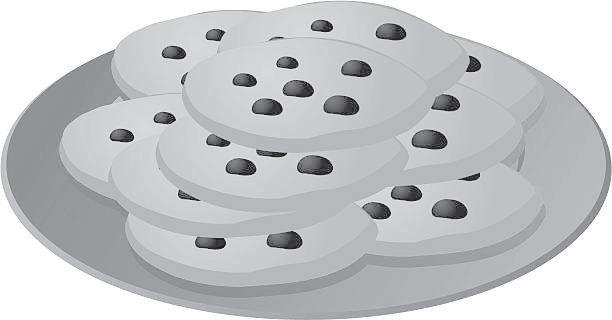
Nick Niemerg, assistant director of constituent relations, discussed how respondents were unhappy with SIUE’s resources and how the Queer Staff and Faculty Association has had trou ble getting attention among LGBTQ+ staff and faculty.
“The satisfaction of services provid ed to LGBTQIA+ employees had a very resounding similarity to [other staff],” Niemerg said. ”Thirty percent of faculty




“It’s a little tricky,” Niemerg said. “The loss of access to the announce list has proved to be a little bit of an issue to get the word out that the group exists.”
Sheila Caldwell, Vice President for An ti-racism, Diversity, Equity for SIU, stated that while not everyone at SIUE filled out the survey, the ones that have something to say typically do, as someone that has had an incident occur to them would be more like ly to respond to the survey than one who didn’t. This gives a general idea of what action needs to be taken by the school and how organizations can better focus on how to combat these issues.
PAGE 4 follow the alestle @alestlelive See you on the Internet! @TheAlestle @Online Editor Alestle @thealestle the student voice since 1960
THE
Thursday, December 1, 2022 Vol. 76 No. 12 GSA uses bake sale as counter
PAGE 3
Author presents book about civil rights hero at East STL
alestle
Southern Illinois University Edwardsville
protest
PAGE 8
Spiller defends the women’s soccer team with a passion
responded that they were dissatisfied with
“
SIUE is a predominantly white institution, I even pulled some information from the fact book, in 2018 to 2021 we only hired 14 Black faculty members out of 105. ”
Jerrica
Criminal Justice Scholarship honors passed alumni
 LIV KRAUS reporter
LIV KRAUS reporter
The Criminal Justice De partment has a new scholarship for current students called “The Ryan K. Marten Memorial Schol arship.” The scholarship was cre ated in memory of criminal jus tice alumni Ryan Marten.
Kevin Cannon, department chair of Criminal Justice Studies, said after hearing about Marten’s death, the department initially decided to rename their “Out standing Graduate Award” to “The Ryan K. Marten Memorial Scholarship.”
Cannon said Marten’s sister was also a criminal justice alum nus. He said they were able to get in contact with her and inform Marten’s family of their plans.
“When we were in contact with her, and let her know what we wanted to do, the family was very supportive,” Cannon said.
During his time at SIUE, Marten was one of two students to be selected for an internship with the United States Marshal Service and was later offered a job as a U.S. Marshal.
Retired professor P.A. Dirks-Linhorst, said she had Marten in one of her internship classes and worked with him while he interned at the co-op
program with the United States Marshal Service.
“Of course, he did great with them and they offered him a job as soon as he finished the co-op program,” Dirks-Linhorst said. “It’s at that point that he started his career with the United States Marshal’s Office, which he was with when he died.
Marten kept in touch with the Criminal Justice Department after he graduated.

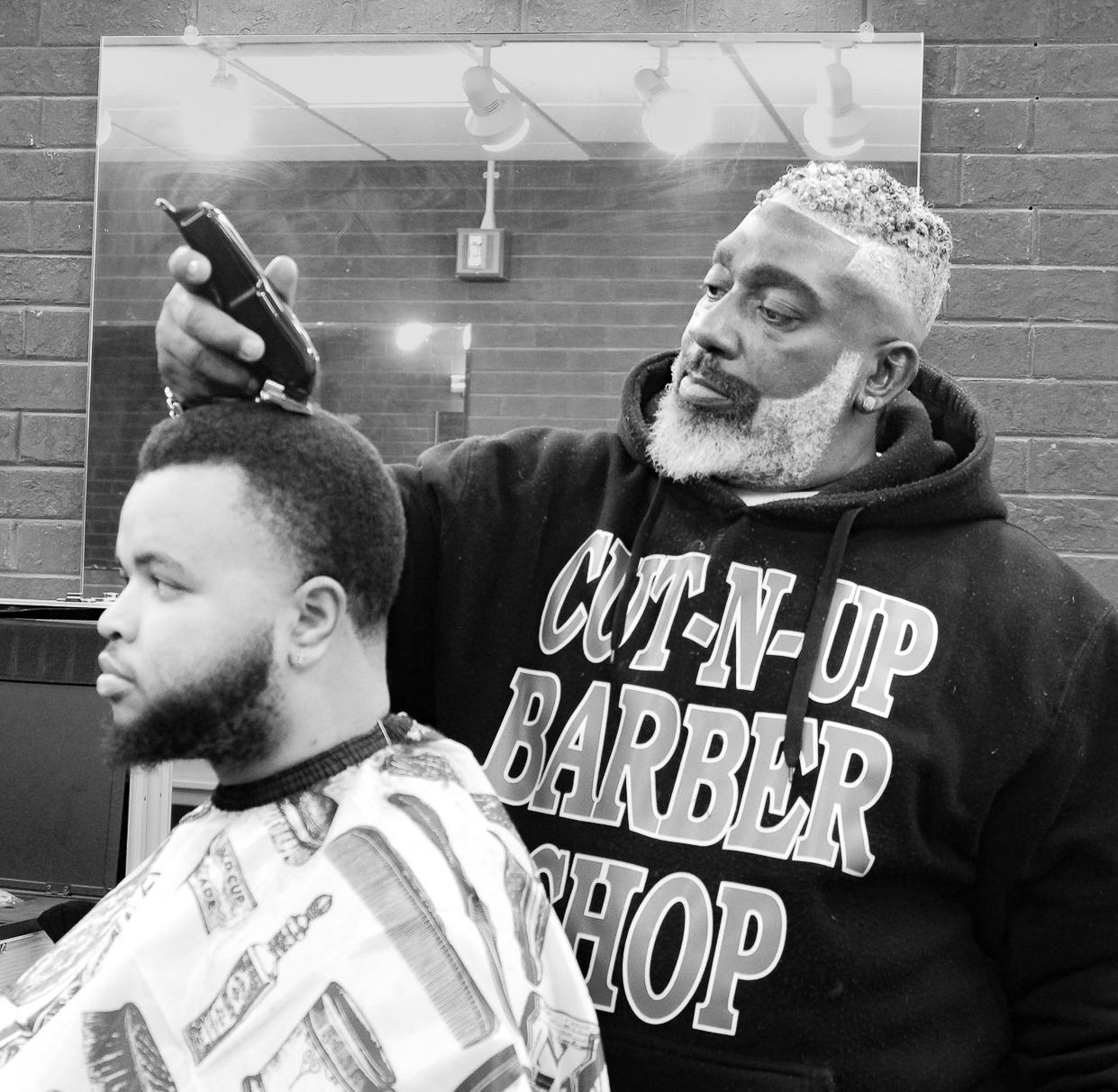
Dirks-Linhorst said Marten was a great, kind and humble stu dent. She said he was very focused on working in the criminal justice system.
“He was incredibly person able,” Dirks-Linhorst said. “He was very kind and he’d do any thing for his fellow students or anything that the co-op asked him to do.”
Dirks-Linhorst said she worked with Marten when he was the internship coordinator for the U.S. Marshals at their St. Louis Office. She said he often partic ipated in career fairs held by the criminal justice department.
“He had a booth at our very first criminal justice career fair because he was very supportive of not only the US Marshals office, but kind of reaching back and continuing to help our students,” Dirks-Linhorst said.
Senior director of develop
ment Kyle Moore said the schol arship is open for junior and se niors majoring in criminal justice who have a strong interest in en tering local, state or federal law enforcement upon the comple tion of their degree.
Moore said the criteria ap plicants must meet includes good academic standing with a cumu lative GPA of 2.5 or higher, two letters of recommendation and a 500 word essay detailing their long-term goals.
“Preference is given to cur rently employed law enforcement officers, or military veterans and also to students that show out standing drive and motivation as a profession,” Moore said.
Moore said “The Ryan K. Marten Memorial Scholarship” is a great scholarship that is impact ful for students.
“Anytime we can put to gether something like that, it lets them achieve their educational as pirations and does some good for the campus,” Moore said.
Cannon said after the first year, Marten’s friends and fam ily had set up a foundation to assist students in the Criminal Justice Department. He said instead of an award given to a graduate student, the donations were turned into a scholarship for current students.
“Last year was the first time
that we awarded it as a schol arship, which is now a $2,500 scholarship for students that are still in the middle of their aca demic career,” Cannon said.
Moore said after seeing the fundraising efforts and other sup port for the scholarship, it made more sense to create a separate scholarship dedicated to Marten.
“It makes sense for them to have their own award,” Moore said. “They can leave a lega cy for Ryan on the campus and keep the outstanding award that is currently departmental award, as well in the criminal justice department.”
Dirks-Linhorst said Marten’s family started hosting a golf tour nament to raise money for the scholarship.
“It was just amazing to me that not only did the family come together and fund this ongoing scholarship, but then their plan is to have an annual golf tourna ment,” Dirks-Linhorst said.
Dirks-Linhorst said the last golf tournament was a substan tial event. She said the family had to turn some people away due to how many participants they had.
“I just think that speaks to how well beloved he was by his fellow workers, as well as his family and in the university,” Dirks-Linhorst said.
11.18.22
A taser was found in a student’s room in Ever green Hall. The student was informed that tasers are not allowed on campus. The taser was brought to the Police Department.
11.19.22
A grill cover was taken off of a vehicle in Parking Lot B.
11.21.22
A wallet was found on the 500 side of the Cougar Vil lage Apartments.
The lockers in the men’s locker room in the Student Fitness Center were reported ly damaged.
A traffic accident was reported in Parking Lot B.
A deer was hit on South University Drive near Stadium Drive.
11.22.22
An individual was reportedly camping near the Alton cam pus. After speaking with an officer, they left the area.
alestlelive.com PAGE 2 Thursday, 12.01.22
Blind Man Needs Volunteer Call (628) 900-4432
Don Lott cuts graduate student Caleb Sewell’s hair. Lott owns Cut-N-Up Barber shop located in Edwardsville. Lott will return to SIUE to cut student’s hair Dec. 1, 5, and 7.
| Chloe Wolfe / The Alestle
Gender-Sexuality Alliance uses baked goods to protest against controversial preacher
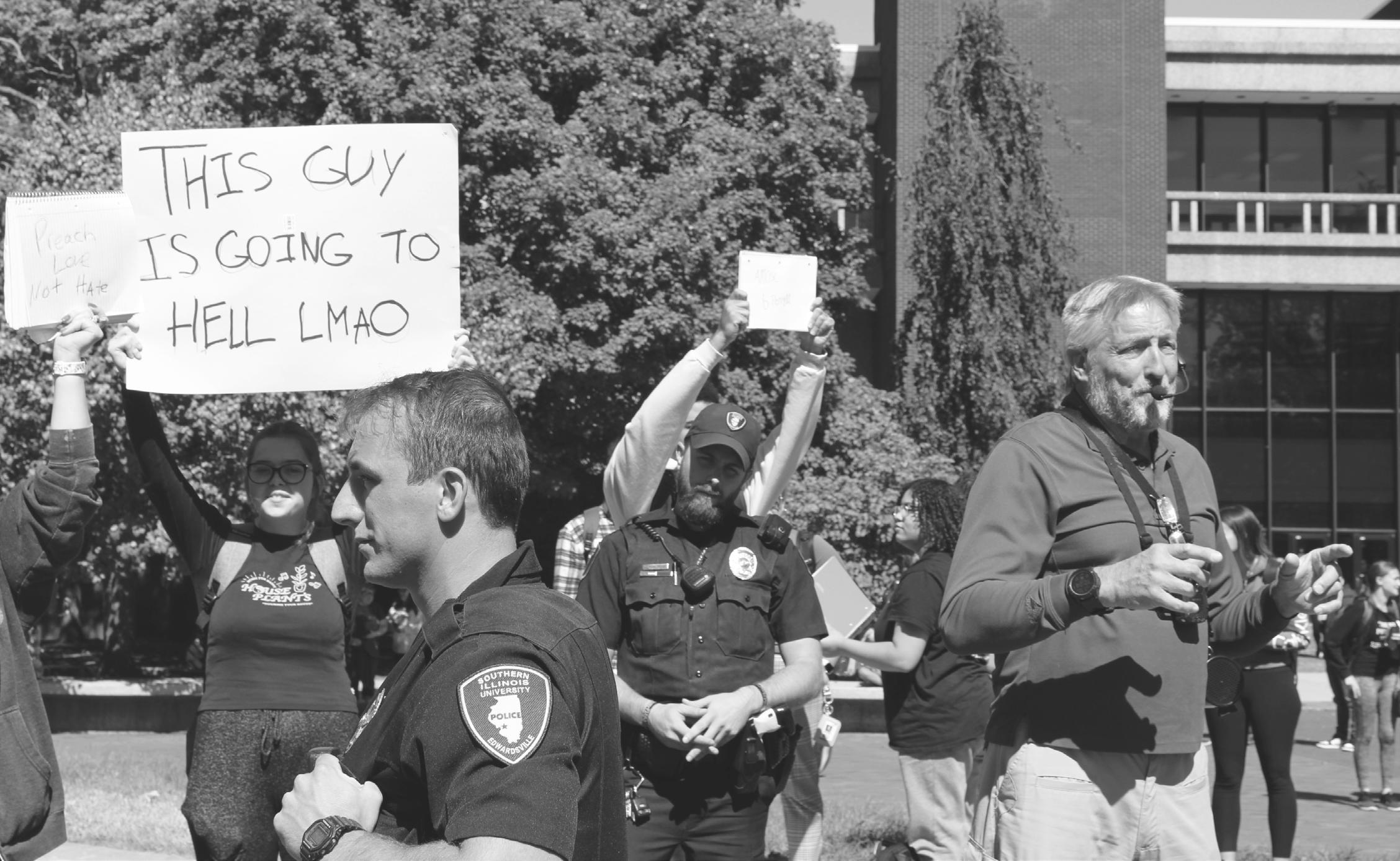 LIV KRAUS reporter
LIV KRAUS reporter
SIUE’s Gender-Sexuality Alliance (GSA) began selling brownies, cookies and other baked goods during local reli gious figure and preacher Tom Rayborn’s visits to campus, act ing as a peaceful protest and safe space for students.
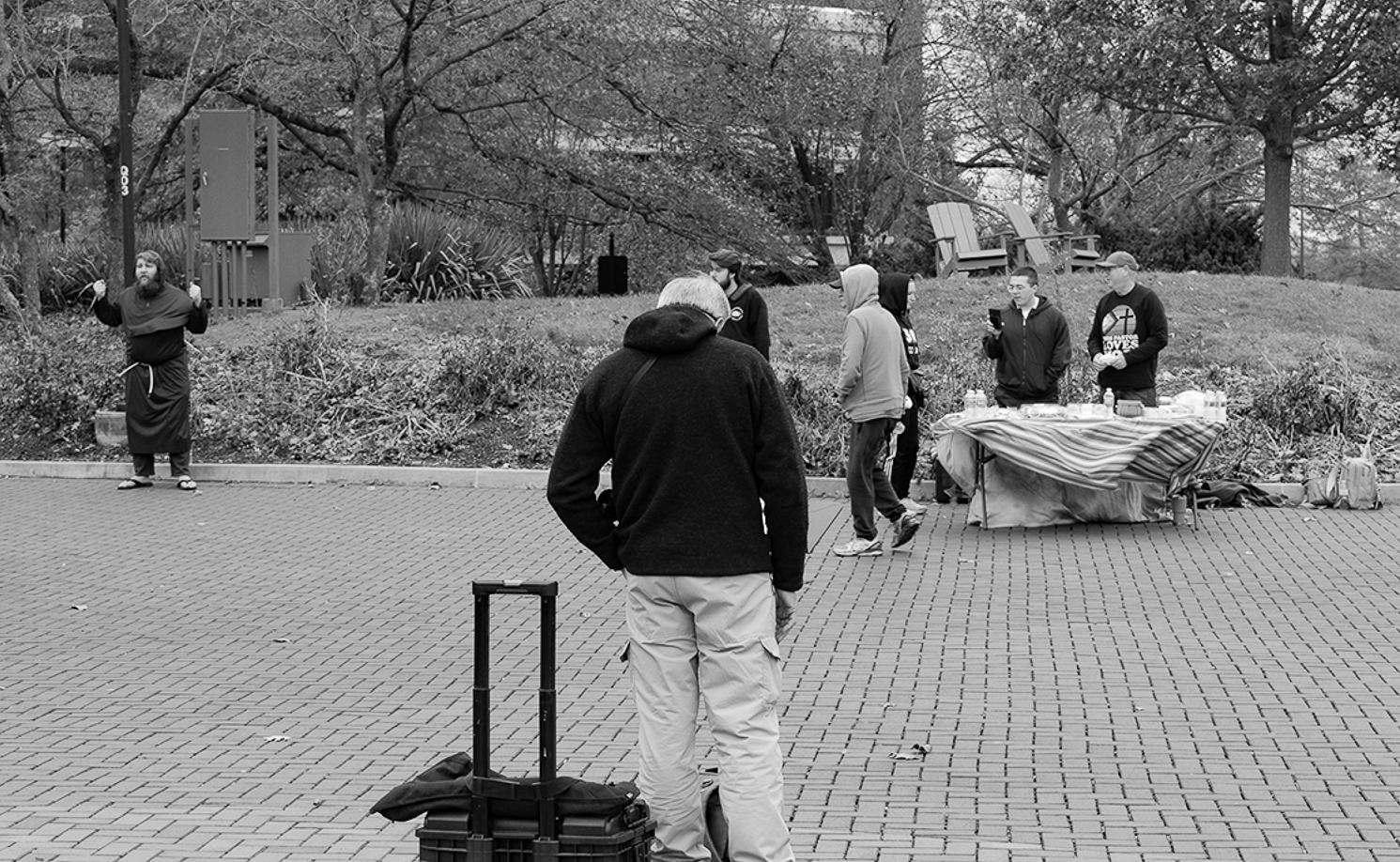
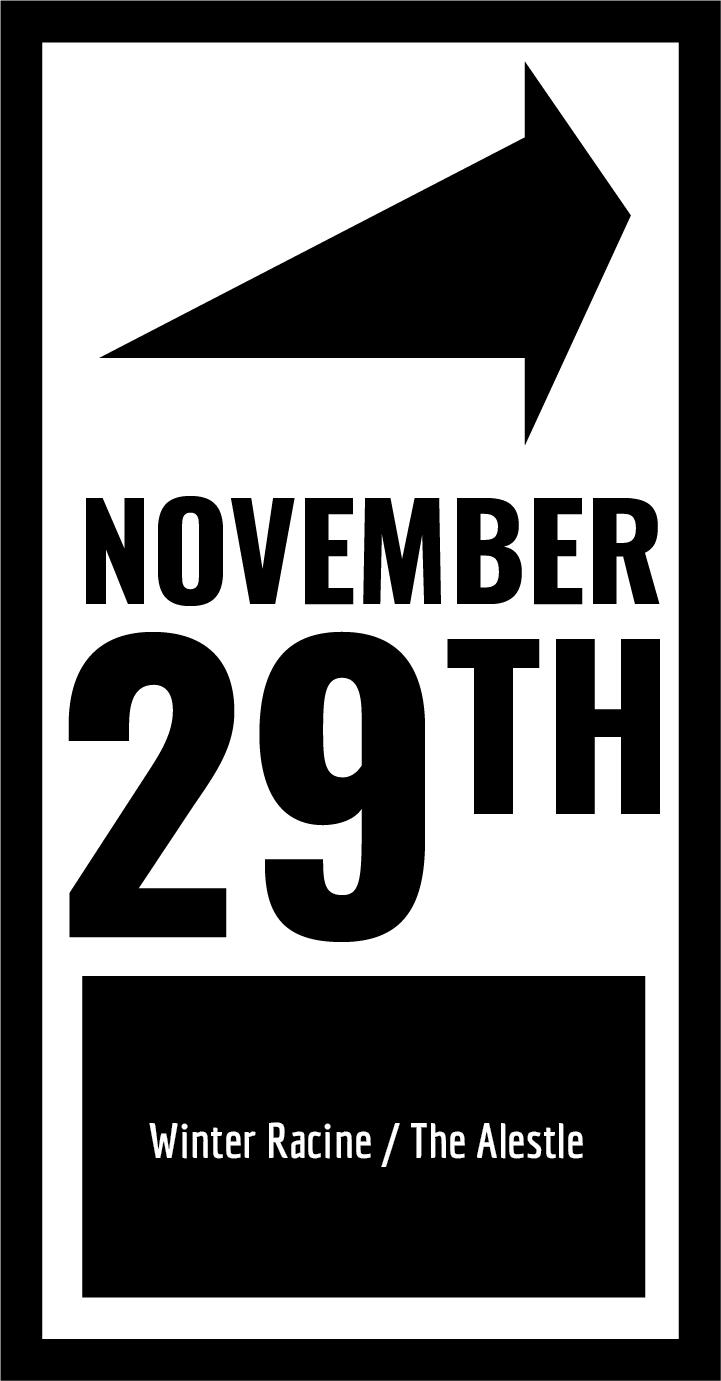

GSA president Stella Smith from Collinsville, Illinois, said after speaking with the other of ficers in the GSA, it was decid ed that a bake sale would be an effective and humorous way to undermine Rayborn and make money during his visits.
“The rest of the campus got involved and it just turned into this huge counter programming event, but it really just started
out as me wanting to make fun of this guy,” Smith said.
Smith said they try to keep the bake sale as simple and re laxed as possible.
“The main thing that we want to do is keep it relaxed,” Smith said. “We don’t want to make it too complicated because the more complicated you get, the less likely people are to show up in support.”
Willow Slinger, sopho more anthropology major from Mooresville, Illinois, is the his torian for the GSA. They said they have seen great support from people since starting the bake sales.
“We have had people do nate without even taking any of the baked goods or anything
like that, so that’s been like a really comforting thing to see,” Slinger said.
Immanuel United Method ist Church Pastor Dave Roder ick said after finding out about Rayborn’s visits, he wanted to find a way to respond peace fully. He was later connect ed with the GSA to help them with the bake sales.
“It’s interesting to hang out with the GSA, and watch what they do,” Roderick said. “They’re not combative or con frontational at all, they’re just there to say to other students that we see you, we respect you, we’re here for you.”
Roderick said he enjoys see ing the different ways students choose to respond to Preacher
Rayborn’s speeches.
“It’s interesting to watch how other students provide their own, either very forward or be hind the scenes protests,” Rod erick said. “Students will find a creative way to do something. That’s something I enjoy about being there.”
Roderick said what he likes about the bake sales is that they’re not only to raise money, but to create a space for individ uals to feel safe and gain a secure sense of community.
“It’s about creating that safe space, that awareness that they know that what’s going on could be harmful to them and it gives them a place to connect with people who may need that,” Roderick said.
Roderick said that he feels honored to be invited to partici pate in the GSA’s bake sales and help create a place that is wel coming, instead of trying to push the belief that one must choose between identity and faith.
“What we want to do is change that narrative, that you don’t have to choose between those two things,” Roderick said. “You can be who God cre ated you to be, and be true to yourself as well, and still follow your faith.”
Smith said they will be continuing their bake sales every Tuesday that Rayborn visits campus.
“As long as he is there, phys ically, we will be there to meet him,” Smith said.
alestlelive.com PAGE 3 Thursday, 12.01.22
contact the editor: lifestyles@alestlelive.com 650-3527
STL author combines poetry, Black history in impactful bio
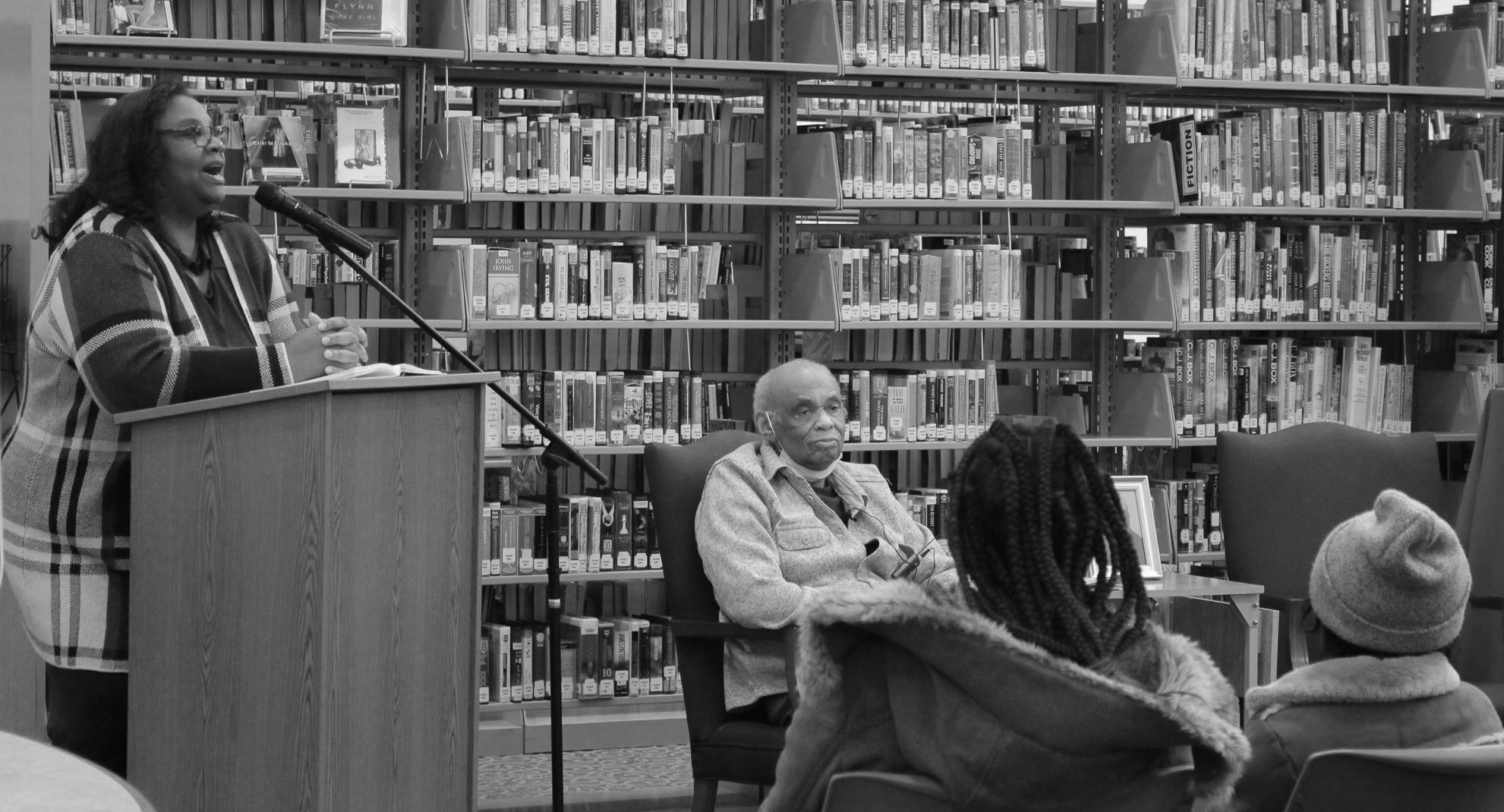
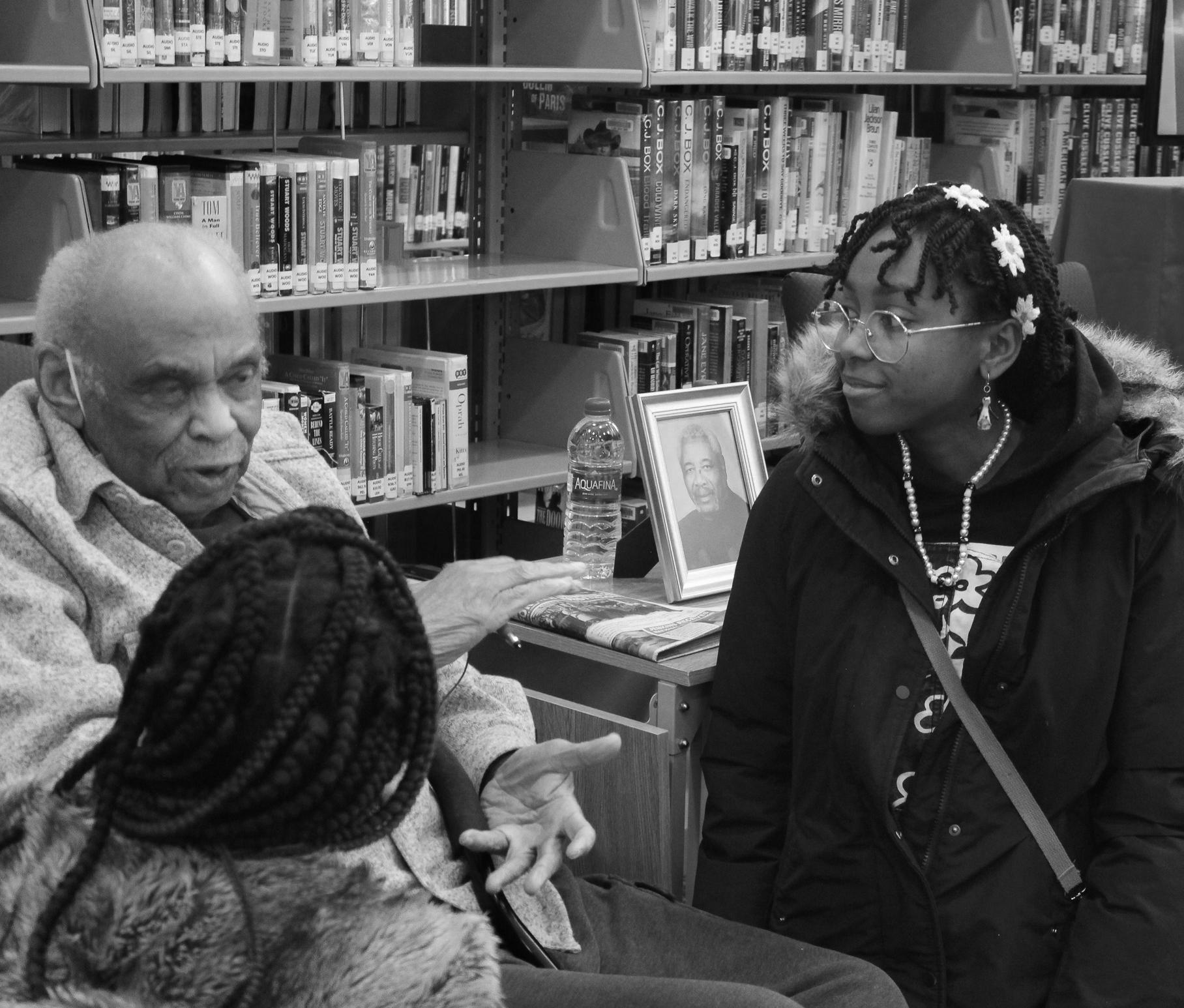 DYLAN HEMBROUGH reporter
DYLAN HEMBROUGH reporter
Author Jaye Willis and Reginald Pet ty paid a visit to the Learning Resource Center to read, answer questions and sign copies of Willis’s book, “The Pandemic Prophet: A Soulistic View of the Socioeco nomic Guinea Worms of Modern Minds.”
Willis’s book details the life of Reg inald Petty, who was one of the first Af rican American Peace Corps Country Di rectors appointed by President Kennedy. Additionally, Petty aided in voter registra tion efforts in the American South during the late 1950’s.
Petty said “The Pandemic Proph et” explores his journey from growing up in East St. Louis to being with the Peace Corps and working alongside Dr. Martin Luther King Jr., John Lewis and Malcolm X.
“Much of what’s in the book is a story about that 87 years,” Petty said. “It was hard to tell a story to improve the life of individuals and change the system in the St. Louis area and the world.”
Petty said that due to being raised during a time when segregation was le gal, he has had many experiences where he wasn’t allowed in many public spaces. He said certain hospitals at the time didn’t ac cept African American patients, resulting in him being born in a hospital that was out of town.
“I had experiences early in life in which I went to the stores and wasn’t able to eat or to even sit,” Petty said. “When getting shoes, you couldn’t wear the right shoes. You couldn’t test the shoes if you were Black, because you couldn’t put them on.”
Author Jaye Willis said “The Pandem ic Prophet” has been in the works for near ly seven years. She said she enjoyed getting to speak with Petty and interviewing him.
“As I’m sitting down talking to him, I let him kind of give me a guide as to what was important to him and who the peo ple were that were important in his life,” Willis said.
Willis said the writing process was difficult at times. She said that persevering was the main key when things were be coming difficult.
“Three quarters of the way through this book and I’m beating my head against the wall going ‘I don’t like this, I’m go ing to rewrite the whole thing’ and that is okay. Keep going,” Willis said.
Willis said her main motivations in writing were her father and Petty. She said
Jaye
to Mr. Petty,” Willis said.
her goal was to finish the book while they were still able to read it.
“I think one of the biggest things that inspired me to keep going was Mr. Petty because I wanted to get this book done while he was still living and could enjoy all of the accolades and roses that he’s re ceived now,” Willis said.
Petty said he is happy to see his story shared and the positive response “The Pan demic Prophet” has gotten.
“My parents and others told me in early life that my life was as important as the life of others,” Petty said.
Willis said she is elated at the response she has received for her book and to find out that it had been sold out on Amazon.
“It helps that people believe in you, but more than anything else, you have to believe in yourself and you have to lean on your faith,” Willis said. “That’s where I ended up having to be and I found that again through Mr. Petty.”
SIUE will be hosting a book reading of “The Pandemic Prophet” with Jaye Wil lis and Reginald Petty, followed by a book signing on Dec. 7.


The upcoming event will take place in the Eugene Red mond Learning Center located in Lovejoy Library.
|
EMILY STERZINGER editor in chief
The Hub hosts several pre-com mencement celebrations celebrating grad uating students of various backgrounds every fall and spring.
A pre-commencement celebration is an event that allows students of diverse backgrounds to be rec ognized and giv en cords and recogni tion certifi cates for their graduation.
Though registration has already closed, which means there is no longer an opportunity for students to receive cords and certificates, students and their families and friends may still attend the ceremonies.
HISPANIC/LATINX GRADUATION
CELEBRATION — Dec. 5 at 4 p.m.
This pre-commencement celebra tion honors Hispanic, Latino, Latinaand Latinx students.
BLACK GRADUATION CELEBRATION — Dec. 6 at 4 p.m.
This pre-commencement celebration
“I didn’t want to be thanked,” Reginald Petty said about his work. Pic tured are Petty (Left), Salah Wilson (Center) and YaAsantewa Tafari (Right).
| Chloe Wolfe / The Alestle
Celebrations for diverse grads lead up to commencement
honors African American and African students.
RAINBOW GRADUA TION CELEBRATION — Dec. 7 at 4 p.m.
This pre-commence ment celebration hon ors students who are part of the LGBTQ+ community.
AAPI GRADUATION CELEBRATION — Dec. 7 at 4:30 p.m.
This pre-commencement celebration
honors Asian, Asian American and Pacific Islander students.
NON-TRADITION AL GRADUATION
CELEBRATION— Dec. 9 at 5 p.m. This pre-com mencement celebration honors non-traditional un dergraduate students.
For more information on these pre-commencement celebrations, visit the Hub’s website
NEXT WEEK: METRO EAST EATS FEATURING THE FOUNDRY
alestlelive.com PAGE 4 Thursday,
lifestyles
12.01.22
Willis, the author who wrote the book which describes the life of Reginald Petty, explained how everyone she interviewed for her book only had good things to say about him. “ this book, there is nothing but praise to give
Chloe Wolfe / The Alestle
Metal, leather artwork up for sale at Native American Holiday Market
DYLAN HEMBROUGH reporter
From dolls and spiders to flutes and medicine bags, Native American artists showed off a wide variety of handmade artwork in the annual Cahokia Mounds Holiday Market.
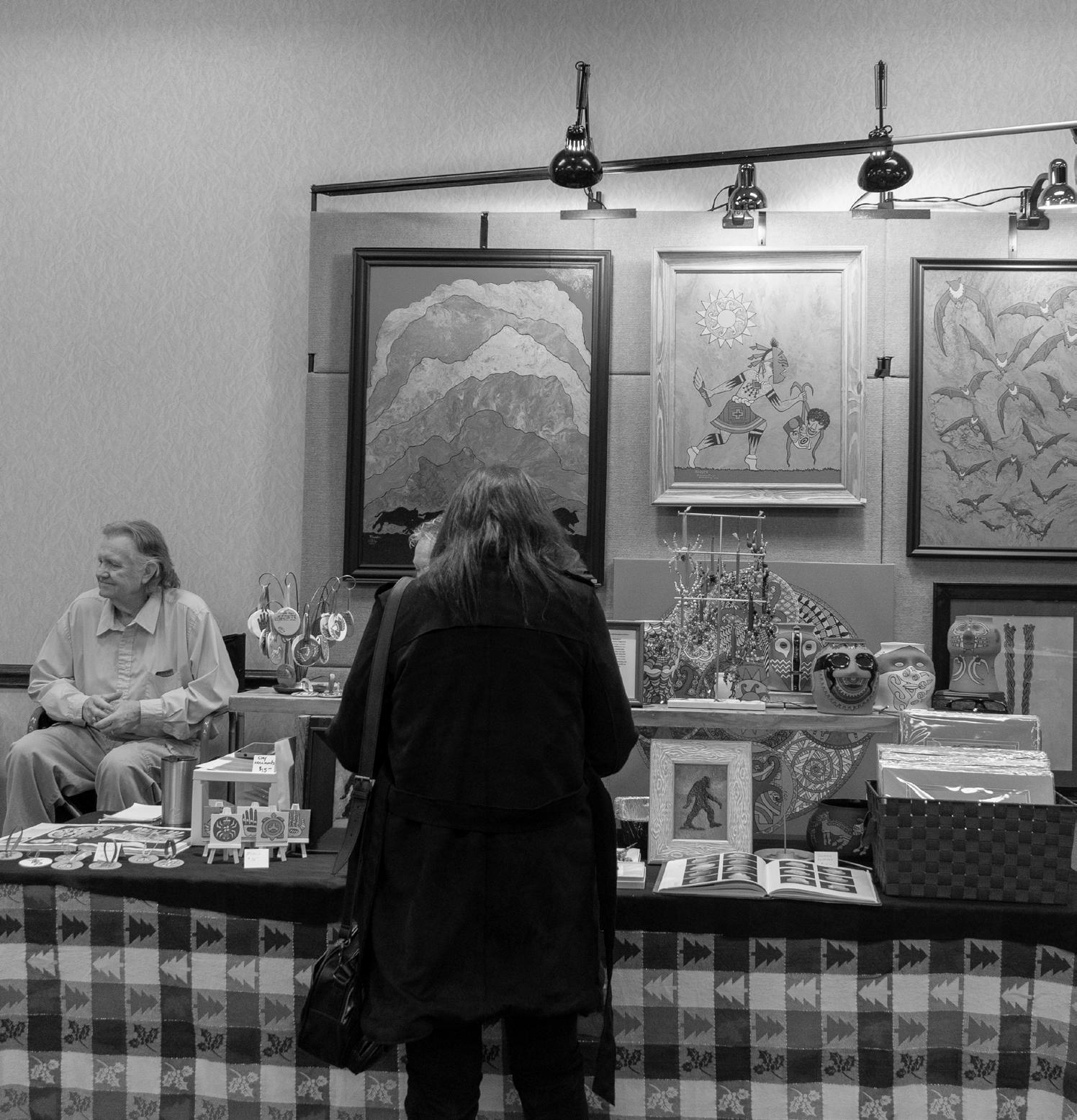
The Cahokia Mounds Holiday Mar ket was coordinated by Linda Krieg, who said she has been working for Cahokia for 25 years. Krieg said the Holiday Market, one of two showcases held throughout the year, started out small.
“We started 19 years ago for this show,” Krieg said. “The first year I had it, I had 5 artists. They don’t know you, you don’t know them.”
Krieg said that since then, the show has grown quite a bit, now incorporat ing a much wider variety of cultural and tribal backgrounds.
“The show now contains 39 artists from 50 states, and they represent Iro quois, Mohawk, Creek, Navajo, Zuni, Hopi, who come together with paintings, sculptures, metal art, baskets, jewelry, hide paintings, musical instruments and much more,” Krieg said. “We carry as many dif ferent tribal affiliations as we can locate to come.”
William Harjo said his work has pro vided for his family, as well as taken him around the world. Harjo, a flute maker and member of the Muscogee Creek tribe, said he has branched out from the river cane he first began with.
“I’ve been making wind instruments, the Native American Indian flutes, for over 30 years. I make them out of river cane, cedars, exotic hardwoods,” Har jo said. “Here today I’ve got woods from Hawaii.”
Harjo said his journey with flute mak ing originally began as a way to earn mon ey through unemployment.
“I started making flutes [for] eco nomic improvement. I quit my job as an alcohol and drug counselor because of stress,” Harjo said. “For a stress reliever, I had a flute that was given to my son, and it was made out of river cane, and it just hap pened where I moved there was river cane, so I started reproducing wind instruments like the one he had.”
Harjo said his first big order for the flutes was for a quantity of 50 for
a powwow.
“My son was a dancer in the powwow world … In order to get him to powwows, I made a handful [of flutes] to take to oth er vendors and sell them for gas money or an evening out. After a while somebody said, ‘Can you make one like this?’ showed me a different one and I said, ‘Sure.’ He said, ‘Well, I’ll take 50 of them,’” Harjo said. “I’ve been making flutes and taking them to powwows ever since.”
Harjo said his flute business has not only gotten him through unemploy ment, but also enabled him to finance his son’s education.
“I got my son through high school and through college, and I also pur chased a house,” Harjo said. “It’s been pretty lucrative.”
Harjo said he has also sold CDs and had the opportunity to do a number of tours in Europe because of his flute making career.
Victoria McKinney, Arkansas na tive and member of the Cherokee Na tion, said a lot of the inspiration for her artwork has come directly from Native artifacts themselves.
“I started seeing the iconology in the pictures in my textbook, and I was blown away. Normally when you think of Native American art, you think of teepees and cactus with coyotes and things,” McKin ney said. “This stuff just captured me. I’ve never had any art training, but I wanted to do something with these images, so I started out with pottery, and then moved onto painting.”
During the pandemic, McKinney said she did extensive research on the role of spiders within Native American folklore.
“Spiders were part of what I re searched. I’d go to museums, I’d go to archaeology conferences, I’d go to dig sites,” McKinney said. “Spiders are a big thing for this branch of the mound builders in the Mississippi River valley here. I’ve just incorporated some of the different stories, and being Cherokee, I was interested in some of their origin stories as well.”
Krieg said the vast majority of what we know of the Cahokian mound builders is based off of archaeological finds at dig sites like the ones McKinney attended.
“We don’t have anything written, be cause it’s prehistoric, so we go according
to what we believe from the archaeological digs,” Krieg said.
McKinney said much of her inspira tion came from a dig site at Cahokia, so the area is of special interest to her.
“Cahokia is a big inspiration for me as well … One of the things that impressed me about being able to go to the dig sites was that, being friends with the archaeol ogists there, I got to get down into the pit and got to see what they were doing,” McKinney said. “When you go to a mu seum, you have to have the gloves on, and little trays come out and you look at things, and you might not be able to touch them.”
McKinney said one of the most excit ing experiences she had was actually being able to handle the artifacts themselves in
the dig site.
“They found a little bone fish hook, and they just turned around and put it in my hand,” McKinney said. “It doesn’t sound like much, but it was a thrill for me, especially when you think about how many eons ago that somebody fashioned that and it got left in the earth for some reason, and you don’t know whoever touched it last.”
Victoria’s husband Tom said she has done a lot of work popularizing “south eastern motifs,” such as the imagery in her art. Tom also said Victoria has spent over twenty years encouraging tribes to empha size their own cultural traditions in their art, and they have been met with success.
For more information on Cahokia Mounds, visit its website.

REVIEW: ‘She Said’ shows power of storytelling in accountability
NICOLE BOYD opinion editor
“She Said,” which chron icles the two New York Times journalists who uncovered Har vey Weinstein’s abuse, celebrates survivors and the role of journal ism in holding the powerful ac countable.
The majority of the movie’s conflict is based on New York Times journalists Jodi Kantor and Megan Twohey working to break the story about Weinstein’s abuse, but being faced with ob stacles such as non-disclosure agreements, threats of lawsuits and most importantly, sources fearing what will happen if they go on the record. While Kantor and Twohey sympathize with Weinstein’s victims, they des perately need a quoted source to corroborate the information they want to publish.
As a journalist, I firmly be lieve in the power of the press when it comes to holding abus ers – and the systems that pro tect them – accountable. As
a feminist, I also understand the importance of a survivor’s choice in how and when they tell their story.
“She Said” did an excellent job of showing the tension be tween these two concepts and how journalism has historical ly not always been the tool for justice that it should be. How ever, as Twohey emphasizes to a hesitant source, telling her story won’t change what hap pened, but may protect others in the future.
Dramatic nonfiction tends to be one of two extremes: bor ing and drawn-out, or sensation alized in a way that tends to dis respect victims. However, “She Said” was neither.
Although it was a bit slow in some parts, it told multiple survivors’ stories as well as the newsroom drama while keeping a coherent storyline. While many of the survivors’ stories were shown through flashbacks, there was not a single rape scene, and all of the survivors were shown in a respectful light.
It’s better for the movie to be
more slow-paced than risk sensa tionalizing Weinstein’s abuse, and it offered a more realistic look into the journalistic ethics and challenges behind investiga tive pieces – should a source be granted anonymity, even though it may damage the credibility of the article? How long should the “other side” be given to respond when on a deadline? What’s a journalist to do when a story needs to be told, but their sourc es won’t talk?
The movie ends with a har rowing statistic: in the first month after the story broke, 82 women came forward with accusations against Weinstein. It only took two women to go on the record and tell their stories. If the rest of the movie doesn’t convince the viewer of the importance of jour nalism, this should.
After that statistic, there is a line of text about the #MeToo movement that followed. How ever, there is a painful irony in seeing Brad Pitt listed as an ex ecutive producer, as Angelina Jo lie recently accused him of abuse in their ongoing legal battle.
It’s disheartening to see a mov ie exposing widespread abuse in Hollywood was partly made by another Hollywood powerhouse accused of abuse.
“She Said” is a powerful de
piction of journalistic success in taking down Weinstein. But as Kantor muses, how many other Weinsteins are out there? There is still so much work to be done within the #MeToo movement.
alestlelive.com PAGE 5 Thursday, 12.01.22
A customer browses a collection of handmade items sold by Victoria McKinney, owner of Panther Snake Studio. | Winter Racine / The Alestle
| via Universal Pictures
Late Night at the MUC hosts S’moresgiving event in the Goshen Lounge
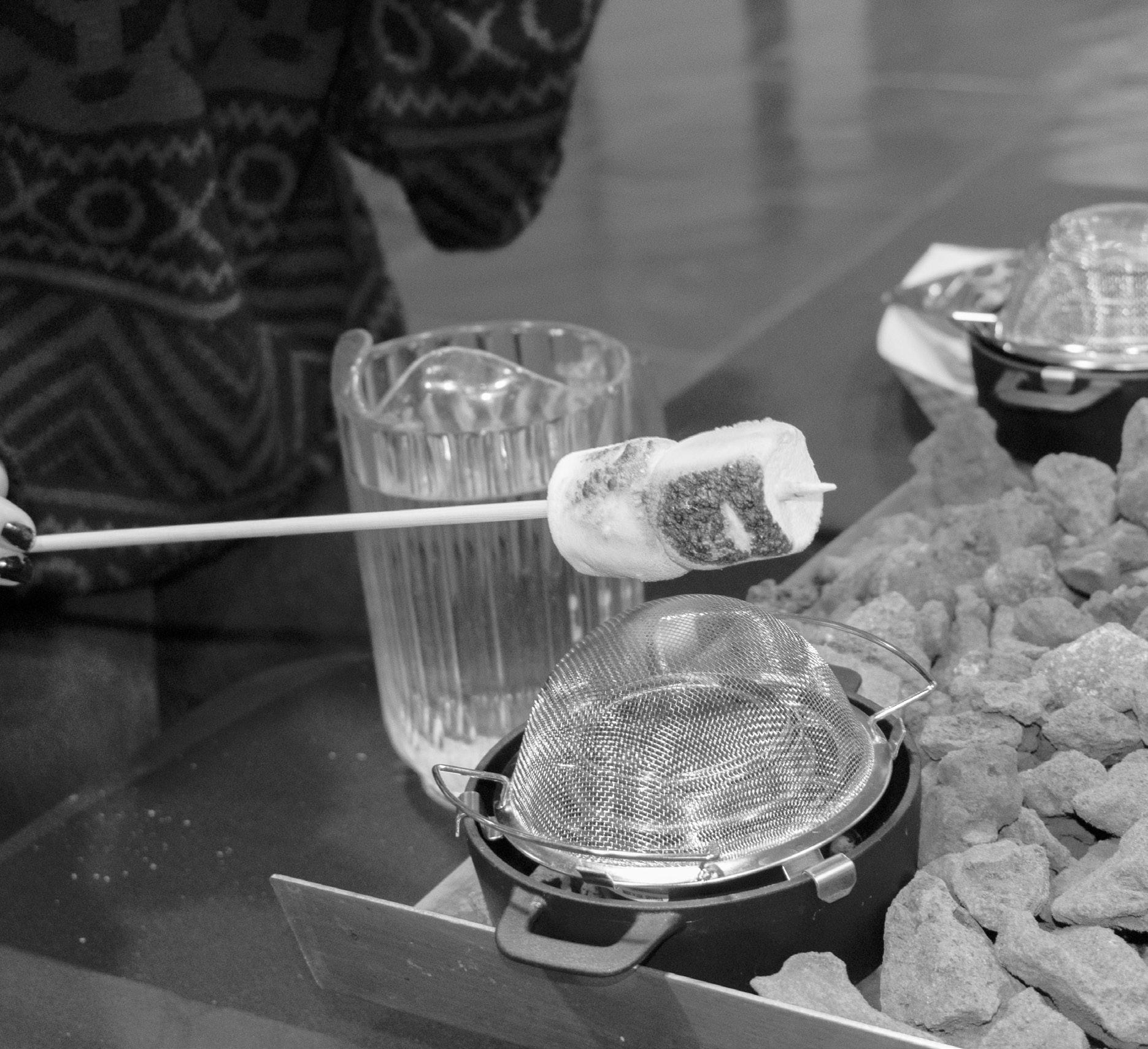
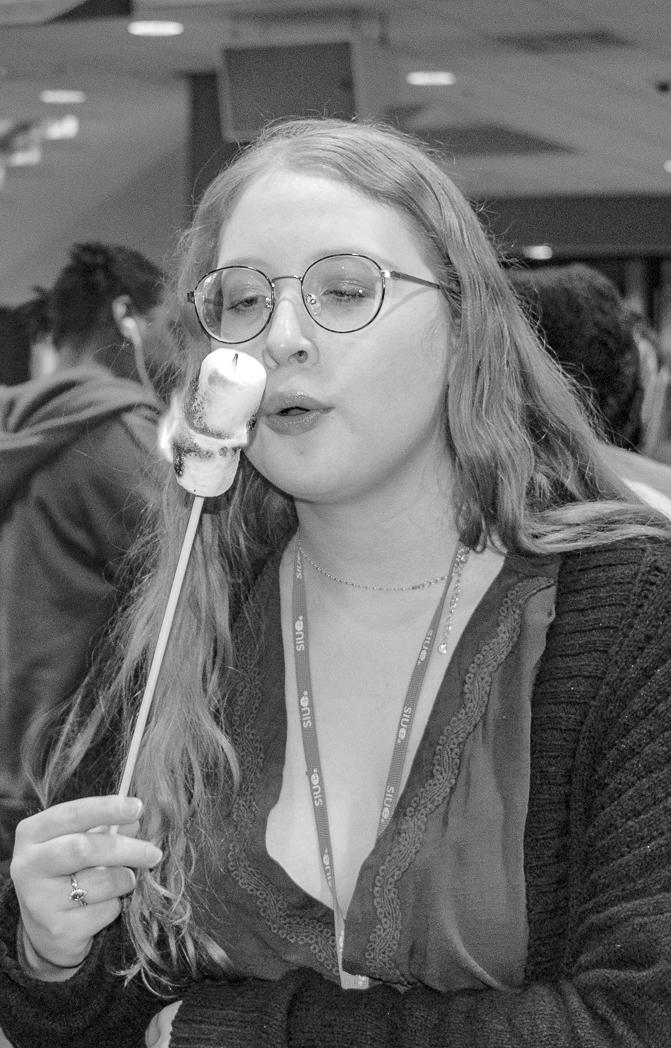
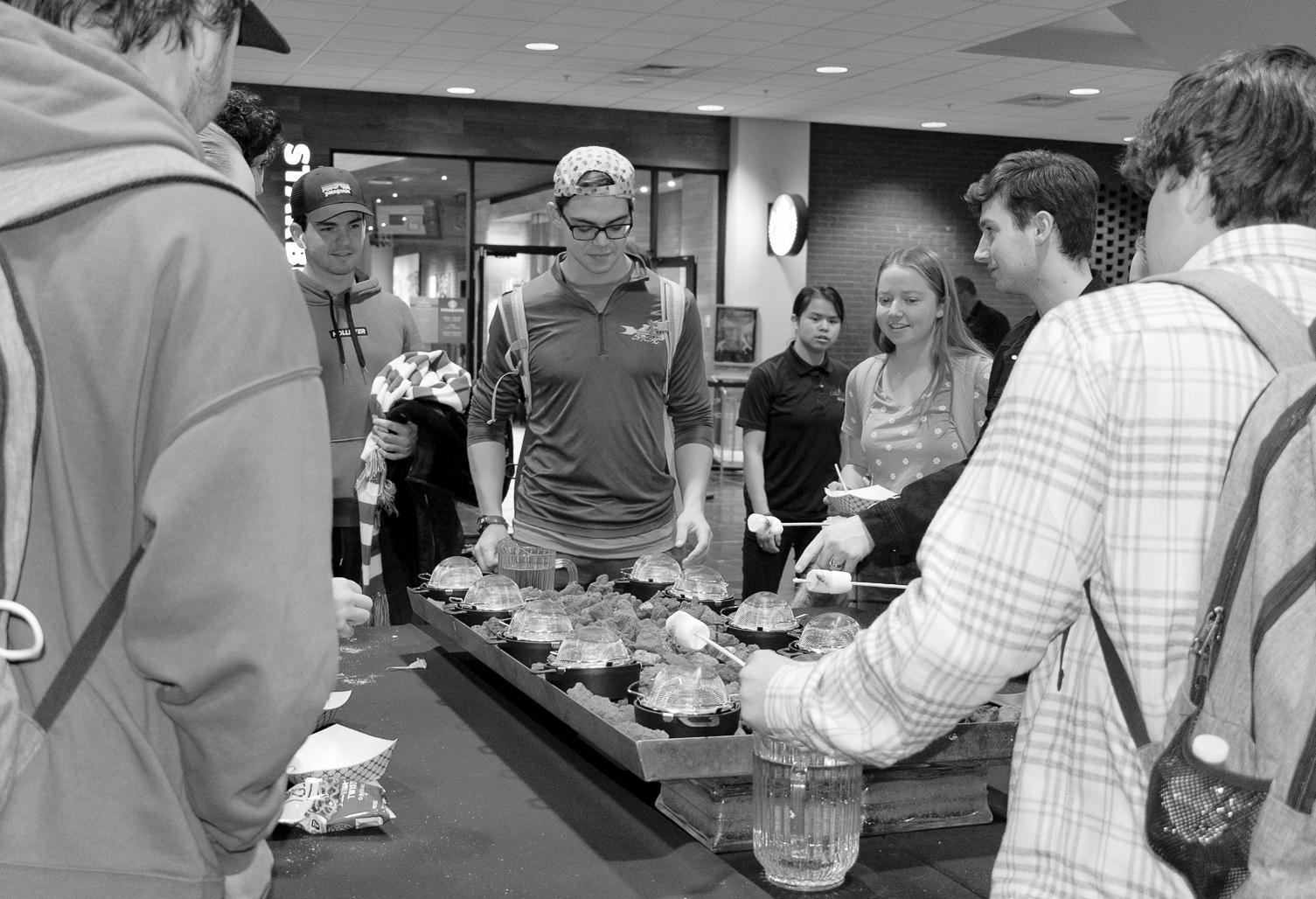
alestlelive.com Thursday, 12.01.22 PAGE 6
Sophomore psychology major Edith Pointer blows out the fire on her marshmallow. | Winter Racine / The Alestle Some students preferred their marshmallows burnt.
| Winter Racine / The Alestle
Students gather around tabletop fire pits to roast their marshmallows.
| Winter Racine / The Alestle
NEXT WEEK: LEFTISTS SHOULD EDUCATE, NOT ALIENATE
OPINION
EMILY STERZINGER Editor-in-Chief

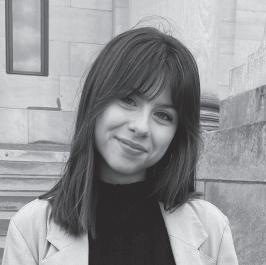
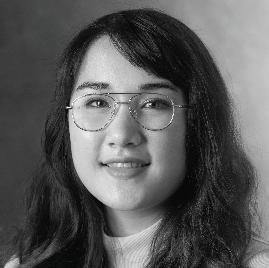 GABRIEL BRADY Managing Editor
GABRIEL BRADY Managing Editor

 FRANCESCA BOSTON Lifestyles Editor
BRANDON WELLS Sports Editor
FRANCESCA BOSTON Lifestyles Editor
BRANDON WELLS Sports Editor
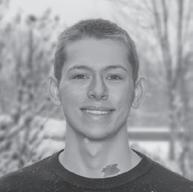 DAMIAN MORRIS Multimedia Editor
DAMIAN MORRIS Multimedia Editor
 O’LOUGHLIN Graphics Manager
O’LOUGHLIN Graphics Manager
HAVE A COMMENT?

Let us know! opinion@alestlelive.com Campus Box 1167 Edwardsville, IL. 62026-1167

LETTERS TO THE EDITOR POLICY:
The editors, staff and publishers of The Alestle believe in the free exchange of ideas, concerns and opinions and will publish as many letters as possible.
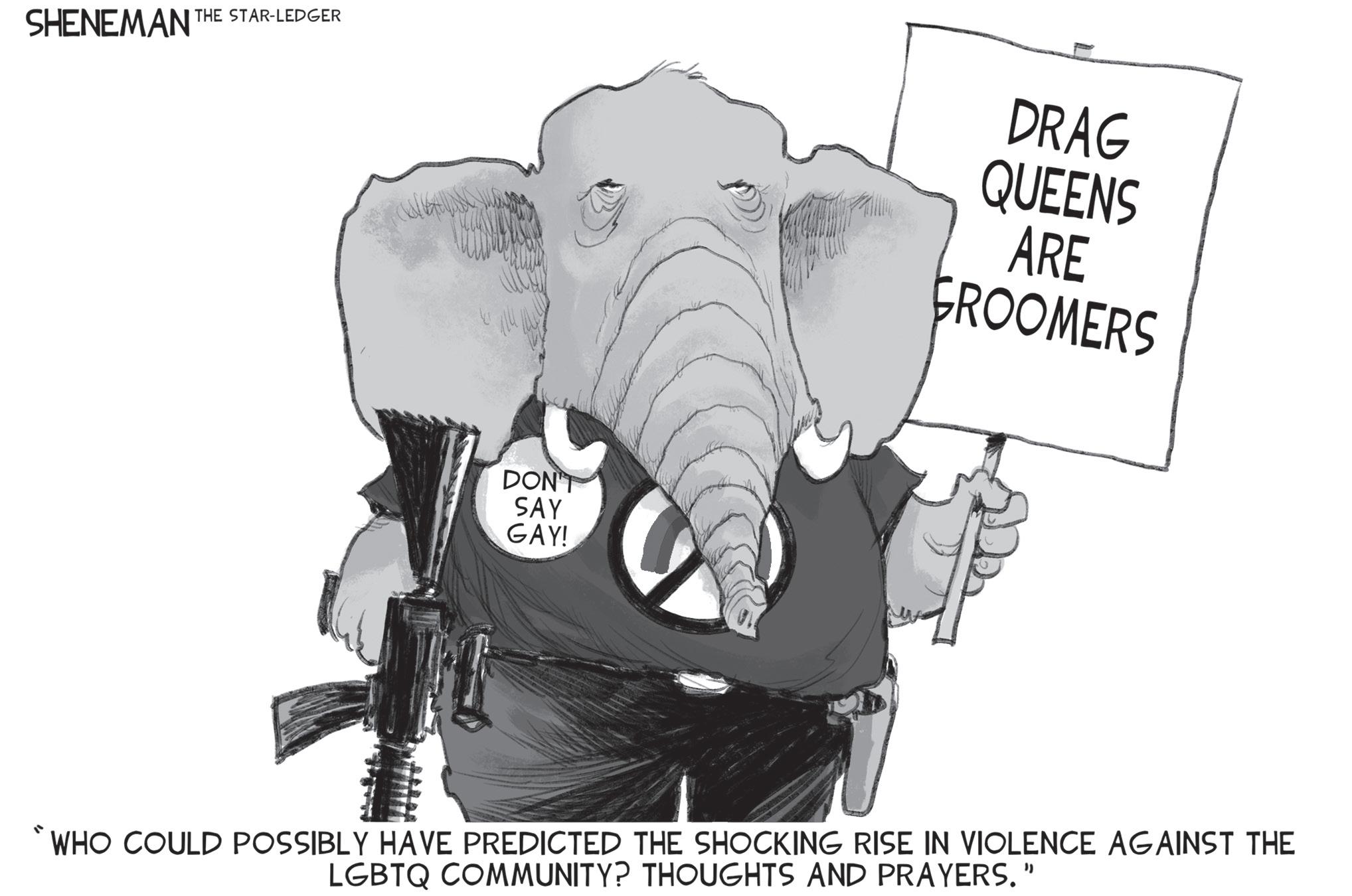



Letters may be submitted at The Alestle office: Morris University Center, Room 0311 e-mail: opinion@alestlelive.com
All hard copy letters should be typed and double-spaced. Letters should be no longer than 500 words. Include phone number, signature, class rank and major.
We reserve the right to edit letter for grammar and content. Care will be taken to ensure that the letter’s message is not lost or altered.
Letters to the editor will not be printed anonymously except under extreme circumstances. We reserve the right to reject letters.

The name Alestle is an acronym derived from the names of the three campus locations of Southern Illinois University Edwardsville: Alton, East St. Louis and Edwardsville.

The Alestle is published on Thursdays in print and on Tuesdays online during the fall and spring semesters. A


For more information, call 618-650-3528.
For advertising, email advertising@alestlelive.com.
Share your thoughts: opinion@alestlelive.com 650-3527
Cougar Controversies
view
Don’t be a Scrooge, donate year-round
THE ALESTLE STAFF editorial board
The holiday season is lnown as a time for giving back, but there are people in need the other 11 months of the year, too.
In fact, 30 percent of all annual donations in the U.S. are made in December alone.
Financial donation is a great way to give back, especially during a season of gift giving and receiving.
Many people are not only caught up in emotions of the holiday season but also use the end of the year to take advantage of tax benefits that are associated with philanthropy. While holiday donations are wonderful, supporting reputable charities year-round is even better.
Charities typically receive a huge influx of money around the holidays, which is beneficial in keeping the charities going, but these charities need support year-round. Reputable charities often struggle halfway through the year because of the lack of financial giving.
A huge part of charitable giving is finding and consistently giving to a reputable charity. You can check out a charity’s reputation with the Better Business Bureau and the IRS 501(c)3 organizations database to make sure it is a real charity, while Charity Navigator can be used to verify the ethics of specific charities.
Another way to support charities year-round is to donate more than just money. Donating your time and labor, especially to small local charities can make a
world of difference to your local communities.
Many SIUE clubs and organizations have created strong relationships with local charities and work to help these charities year-round, but the best way to support and uplift communities is to donate time, money and labor consistently, not just once or twice, or just during the holiday season.
Don’t forget blood donation. Oddly, regular blood donors tend to forget to donate around the holidays, and winter is often a time blood banks need more donations. It doesn’t cost you a thing, and you can literally save a life.


Another reason to donate year-round is financial stability. The holidays are often stressful for many people, trying to create
the best experience for their families and celebrate the holidays in the best way, but another reason to donate year-round is that donating both money and time has proved mental and physical health benefits.
Social connection is immensely beneficial for mental health, and having a regular routine of giving, especially of labor, can be great for physical health as well.
This holiday season, find a charity to support, a reputable charity working to improve something you are passionate about, make a donation and then create a plan to donate throughout the year.
Find a charity in Edwardsville or your hometown to volunteer at regularly, and support your community year-round.
Vegan students are left out by Dining Services
BRANDON WELLS reporter
In recent years, SIUE Dining has made more efforts to give vegetarian options, but still leave vegans with few choices.
Veganism is a dietary lifestyle that involves the complete exclusion of all animal products usually due to animal cruelty and exploitation used to make many of the products people use.
The vegan diet and lifestyle have gained popularity over the years, and according to Food Revolution Network, plantbased dairy and meat sales were over $29 billion in 2020 and are expected to increase in the near future.
People for Ethical Treatment of Animals, an international animal rights organization, provides
a “report card” in which it judges vegan options at universities. According to a recent report, the number of options for vegans at universities has been increasing, so why doesn’t SIUE have many?
According to that same report, SIUE is listed as an F grade in terms of vegan dining options available to students, but this can be said about many schools in Illinois.
When taking a glance at the different dining options in the MUC, there aren’t many places that give vegan options outside of a salad bar and Auntie Anne’s if you don’t get butter on your pretzel. The Grab n Go in the dining area does offer some options, but doesn’t have very much variety overall other than wraps or fruit when it comes to a degree of af-
fordability aside from the pricey Rootberry brand they offer.
Looking at menu options on Nutrislice, which gives nutritional information and daily menus for dining, places such as Boss Burger and Chick-fil-A are obviously off the table. Entrees is also mostly off the table for vegans, which usually offers very few options other than possibly side items. The majority of its menu is meat or contains some form of dairy. Sammiches at least offers vegan cheese and mayo, but that’s all.
It also must be understood that Dining is short on chefs for the food, making it more understandable. At the same time, some of the dishes can simply be substituted for vegan options as opposed to adding more as a
whole.
SIUE is not alone in this problem, however. Many colleges, universities and public schools have had the same problem, so much so that Illinois recently saw a bill requiring public schools to have more plant-based options. House Bill 4089 was passed in May of this year by Governor J.B. Pritzker and amends The School Breakfast and Lunch Program Act by adding that schools must provide plant-based options to students.
SIUE, along with other universities, are behind when it comes to plant-based options, which will need to increase as vegan diets become steadily more common. Vegetarian students aren’t left out, so vegans shouldn’t be either.
print edition is available every other Wednesday during summer semesters.
PAGE 6
alestlelive.com
NICOLE BOYD Online/Opinion Editor
KIRSTEN
ELIZABETH DONALD JANA HAMADE AUDREY O’RENIC Copy Editors
TAMMY MERRETT Program Director
UDIT NALUKALA Circulation Manager
AMINA
SEHIC Offi ce Clerk
ANGIE TROUT
Offi ce Manager
BRUCE DARNELL DYLAN HEMBROUGH LIV KRAUS AHMAD LATHAN Reporters
WINTER RACINE CHLOE WOLFE Photographers
Thursday, 12.01.22
go up at 10
every Monday on Twitter:
spending time with family 51.7% 42.9% 0% good food rest
Which was the best part of your break? Questions
a.m.
@TheAlestle
WEEK: FORMER SIUE SOFT BALL COACHES JOIN TO HEAD LOCAL SCHOOL
BRANDON WELLS sports editor
Redshirt junior goalkeep er Taylor Spiller of Cincinnati, Ohio is one two goalkeepers on the women’s soccer team, a posi tion she found a passion for at a young age.
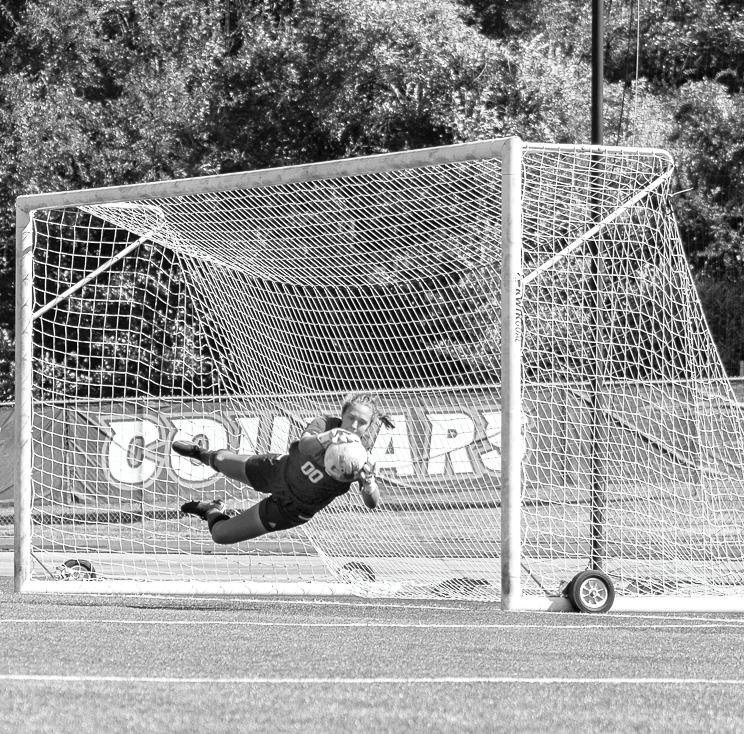
Spiller is majoring in mathe matics and attaining her teaching license to be able to teach k-12 math classes. She said teaching is something she’s always consid ered in her life, so being able to achieve her goals has been great for her.
“It’s kind of always been in the back of my head. Teaching was always a constant from when I was younger,” Spiller said. “In high school, I would find myself sitting in classes and being like ‘Oh, I kind of want to do this in my classroom one day.’”
She said she’s wanting to use what she learns at SIUE to return home to be able to teach closer to her family.
Spiller said her beginning in soccer came from being put in it when she was younger by her mother, and that of her siblings who also tried soccer, she’s the only one who stayed interested in it.
I played for my community team until I was ten and when I was ten years old I tried out at a club team and played club soccer until I graduated high school,” Spiller said.
After playing up to high school, Spiller said she had to make a decision on what position she wanted to play after going be tween goalkeeping and field po sitions throughout her younger years. She said although her team wasn’t the best, she enjoyed being able to feel like she’s defending her team and has since carried that idea on to college.
“I had played a goalkeeper
for halves growing up and I liked it. Goalkeepers are the only ones that can use their hands, and when I was younger I thought that was cool,” Spiller said. “They’re the last person that can touch the ball before it goes into the back of the net and when I was younger I was like ‘I want to stop the ball.’”
Spiller said part of the de cision she made was also due to wanting to be able to play goal keeper more instead of risking not being able to as a part-time goalkeeper on a team.
“Goalkeeping kind of just stuck because I love the feeling of flying and being the last defend er,” Spiller said.
She said being a goalkeep er forces you to experience a lot of stress and pressure, especially when you get scored on.
“As a goalkeeper, you obvi ously don’t want to get scored on that much and that often in ev ery game, and it was really, really frustrating. You had to learn, and I learned a lot through all four of my years [in high school] and never quite took the sting off of getting scored on,” Spiller said.
After picking SIUE as her choice her junior year, Spiller said continuing to play soccer was natural for her and allows her to keep herself active and push her own limits. She said she learned about SIUE through playing soccer.
“I want to see how far I can push myself and how good I can be and how far I can take it in one sense. In another sense, I love it and it is my outlet from every thing else in life, so if I want to get away from school, I can play soccer,” Spiller said.
Spiller said she’s also the first college athlete in her family, and has enjoyed much of her time be ing a part of the women’s soccer team. She said going from high
school soccer to college soccer is still not easy, even if she enjoys it.
“Coming to college, and this is true for most people I believe … It’s a different physical de mand on top of it’s a whole dif ferent mental demand of being away from home if you are, be ing in a completely new environ ment, having to deal with class loads and a whole different type of work load,” Spiller said.
She said she loves getting to be able to be around other people
like her who want to put in the work towards their sport and be ing able to learn different things from the friends she made on the team.
Despite the stress and pres sure of being a college athlete, Spiller said she believes it allows her to have more structure in her college life and has given her many great memories from the friends she’s made on the team and the games she’s played.
“[During one of my first
seasons] somebody put on ‘Don’t Stop Believin’’ in the locker room [and] everyone got up sang to gether and it was the last song before our coach came in to talk. That feeling was incredible, just to feel a part of the team and feel completely connected to every body,” Spiller said. “I’ll never for get that feeling …and since then we’ve done that every year, and we don’t do it before any other game except for conference and any post-season.”
Cross country team ends season at NCAA Midwest Regionals
AHMAD LATHAN reporter
The NCAA Midwest Re gional welcomed the SIUE cross country team to compete against some of the top schools in the area.
Assistant coach Josh Wolfe said the team had some illness es that created struggles during the matchups.
“We had a lot of adversity here in the last couple of weeks, including lots of sickness with in our group,” Wolfe said. “We weren’t at full strength and unfor tunately I think that led to a low er finish at the NCAA Regionals than what we were looking for.”
He said the cross country team had a phenomenal year of training.
“Our finish was not really indicative of how well our season
went, we’re really excited about how this sets us up going for ward,” Wolfe said.
Wolfe said the newer runners on the team are getting good experience competing in these types of races.
“We have a young group, so it is important to get into some of those intense types of races to learn from and get that expe rience,” Wolfe said. “Not only that but also just to go through training to get stronger and can set higher goals.”
The Men’s Cross Country team placed 33rd in the 10k event and the Women’s Cross Coun try team placed 27th in the 6k event. The Cougars’ faced teams from multiple conferences in the Midwest area.
The Cougars’ top runner in the women’s 6K event was Chessy Nikonowicz who finished 204th
in 23 minutes and 37 seconds.
Roland Prenzler led the men’s 10k event with a 31 min utes and 26 seconds and a 115th finish. He earned the fifth fastest 10k race in program history with that mark.
Tulsa brought home the championship for the men’s 10k event and Oklahoma State’s women won the championship for the 6k race.
Junior Cameron Wood ard from Philo, Illinois, said the team’s training was a big factor in how they performed throughout the season.
“I think we just had a better mentality, knowing that we’ve trained super hard, gave it all we had in practice and that translated into our performances during the races,” Woodard said.
Woodard said that he knew the women’s team struggled with
sickness, but the guys did not have many issues with that.
“I don’t remember sick ness being so prevalent for us. I know on the women’s side they have sickness and that definitely negatively affected their perfor mance,” Woodard said.
Woodard said it was tough facing their other op ponents outside of the Ohio Valley Conference.
“It’s a little bit nerve wrack ing because a lot of these schools are bigger than us and some of them are teams that can place na tionally,” Woodard said. “It’s also exciting because you do see com petition that you would normally never get to see, and it makes for a better race overall.”
Woodard said that the com petition makes them work harder.
“I would say it really forc es you to push yourself further
than you might normally do be cause you have to perform better if you want to be competitive,” Woodard said.
Woodard said the biggest thing is holding each other ac countable, making sure that they are putting in the work for them to continue performing well heading into next season.
“The staff is incredibly proud of our group for their effort at both conference and regionals,” Wolfe said.
Wolfe said his student ath letes put in the work while in the classroom and during their respective athletic program. He said that is a reason why the team culture is so intact.
“They’re consummate stu dent athletes that do everything in their power when asked to be successful both in the classroom and at running,” Wolfe said.
contact the editor: sports@alestlelive.com 650-3527
alestlelive.com Thursday, 12.01.22 PAGE 8
sports
NEXT
Redshirt junior goalkeeper Taylor Spiller of Cincinnati, dives to stop the ball in this Sept. 25 game. This was one of 11 saves she had this game. Throughout the season, Spiller had 76 saves like this one overall.
| Winter Racine / The Alestle
 BRUCE DARNELL reporter
BRUCE DARNELL reporter








 LIV KRAUS reporter
LIV KRAUS reporter


 LIV KRAUS reporter
LIV KRAUS reporter




 DYLAN HEMBROUGH reporter
DYLAN HEMBROUGH reporter









 GABRIEL BRADY Managing Editor
GABRIEL BRADY Managing Editor

 FRANCESCA BOSTON Lifestyles Editor
BRANDON WELLS Sports Editor
FRANCESCA BOSTON Lifestyles Editor
BRANDON WELLS Sports Editor
 DAMIAN MORRIS Multimedia Editor
DAMIAN MORRIS Multimedia Editor
 O’LOUGHLIN Graphics Manager
O’LOUGHLIN Graphics Manager











